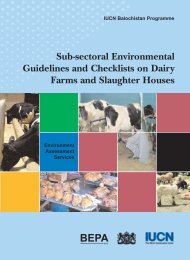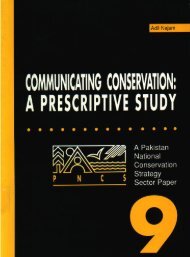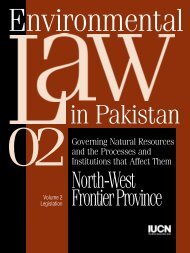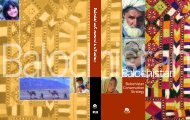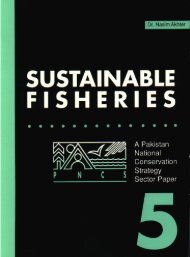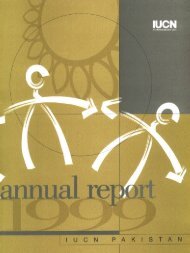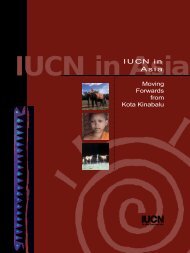- Page 1 and 2: SindhState ofEnvironment &Developme
- Page 4 and 5: Sindh State ofEnvironment &Developm
- Page 6 and 7: Sindh State ofEnvironment &Developm
- Page 8 and 9: HANDSHealth and NutritionDevelopmen
- Page 10 and 11: SINGOFSindh NGO FederationVOVillage
- Page 12 and 13: Sindh State ofEnvironment &Developm
- Page 14 and 15: Sindh State ofEnvironment &Developm
- Page 16 and 17: Sindh State ofEnvironment &Developm
- Page 18 and 19: Sindh State ofEnvironment &Developm
- Page 20 and 21: Sindh State ofEnvironment &Developm
- Page 24 and 25: Sindh State ofEnvironment &Developm
- Page 26 and 27: Sindh State ofEnvironment &Developm
- Page 28 and 29: Sindh State ofEnvironment &Developm
- Page 30 and 31: Sindh State ofEnvironment &Developm
- Page 32 and 33: Sindh State ofEnvironment &Developm
- Page 34 and 35: CHAPTER 1Sindh State ofEnvironment
- Page 36 and 37: Sindh State ofEnvironment &Developm
- Page 38 and 39: Government, which includes the City
- Page 40 and 41: Sindh State ofEnvironment &Developm
- Page 42 and 43: consisting of 8, 10 or 12 members d
- Page 44 and 45: CHAPTER 2Sindh State ofEnvironment
- Page 46 and 47: Sindh State ofEnvironment &Developm
- Page 48 and 49: disturbed by faulting. Consequently
- Page 50 and 51: Table 2.1: Land use in Sindh(In mil
- Page 52 and 53: CHAPTER 3Sindh State ofEnvironment
- Page 54 and 55: Sindh State ofEnvironment &Developm
- Page 56 and 57: Sindh State ofEnvironment &Developm
- Page 58 and 59: EmploymentEMERGING TRENDSSindh Stat
- Page 60 and 61: Sindh State ofEnvironment &Developm
- Page 62 and 63: Sindh State ofEnvironment &Developm
- Page 64 and 65: Sindh State ofEnvironment &Developm
- Page 66 and 67: CHAPTER 4Sindh State ofEnvironment
- Page 68 and 69: Mukhtar AzadThe magnificent Sukkur
- Page 70 and 71: Groundwater SourcesRegular surveys
- Page 72 and 73:
Tahir QureshiDrain carrying industr
- Page 74 and 75:
Table 4.6: Land Use in 1997- 98Land
- Page 76 and 77:
Box 4.1: Waterlogging and SalinityW
- Page 78 and 79:
Muhammad Ali QadriGuddu Barrage on
- Page 80 and 81:
major obstacles in conserving water
- Page 82 and 83:
Box 4.2: Manchar LakeManchar Lake,
- Page 84 and 85:
producing human resources in the wa
- Page 86 and 87:
CHAPTER 5Sindh State ofEnvironment
- Page 88 and 89:
Sindh Agriculture Information Depar
- Page 90 and 91:
Khairpur Nathan Shah) of Dadu distr
- Page 92 and 93:
The extent of soils affected by var
- Page 94 and 95:
Table 5.5: Area, Production and Yie
- Page 96 and 97:
Table 5.7: Quantity of Pesticides s
- Page 98 and 99:
Muhammad Anees ShahzadSunflower Cro
- Page 100 and 101:
Sindh Agriculture Information Depar
- Page 102 and 103:
Sindh Agriculture Information Depar
- Page 104 and 105:
tillage drills for planting wheat a
- Page 106 and 107:
CHAPTER 6Sindh State ofEnvironment
- Page 108 and 109:
Sindh State ofEnvironment &Developm
- Page 110 and 111:
Tahir QureshiUnhygienic handling of
- Page 112 and 113:
Sindh State ofEnvironment &Developm
- Page 114 and 115:
Fishermen's CooperativeSociety (FCS
- Page 116 and 117:
CHAPTER 7Sindh State ofEnvironment
- Page 118 and 119:
Sindh has 25.455 million and 11.861
- Page 120 and 121:
against infectious and contagious d
- Page 122 and 123:
Photograph name ?Commercial poultry
- Page 124 and 125:
Widely promoted technology packages
- Page 126 and 127:
CHAPTER 8Sindh State ofEnvironment
- Page 128 and 129:
Table 1 in Appendix 8.1: Flora in t
- Page 130 and 131:
Khuda Bux AbroWater collection from
- Page 132 and 133:
Nasir Ali PanhwarA dried up well: w
- Page 134 and 135:
degradation of natural resources, t
- Page 136 and 137:
Sindh State ofEnvironment &Developm
- Page 138 and 139:
CHAPTER 9Sindh State ofEnvironment
- Page 140 and 141:
Table 9.1 outlines the forest types
- Page 142 and 143:
Tahir QureshiConstruction of breakw
- Page 144 and 145:
Sindh State ofEnvironment &Developm
- Page 146 and 147:
Khushhali Bank, enabling it to prov
- Page 148 and 149:
Sindh State ofEnvironment &Developm
- Page 150 and 151:
CHAPTER 10Sindh State ofEnvironment
- Page 152 and 153:
Sindh State ofEnvironment &Developm
- Page 154 and 155:
the catchment areas where forests a
- Page 156 and 157:
Muhammad Anees ShahzadDead fish at
- Page 158 and 159:
as coordinate its work with the pro
- Page 160 and 161:
LegislationWetland LegislationEach
- Page 162 and 163:
CHAPTER 11Sindh State ofEnvironment
- Page 164 and 165:
Sindh State ofEnvironment &Developm
- Page 166 and 167:
Coastal Ecosystem:Identification of
- Page 168 and 169:
mining of coal in Thar (Sindh), and
- Page 170 and 171:
Tahir QureshiIndustrial and domesti
- Page 172 and 173:
Stefan Micallef, UNEPTasman Spirit,
- Page 174 and 175:
CAUSES FOR COASTALENVIRONMENTALCOND
- Page 176 and 177:
Muhammad Anees ShehzadTurtle enclos
- Page 178 and 179:
CHAPTER 12Sindh State ofEnvironment
- Page 180 and 181:
Pakistan is among the leading expor
- Page 182 and 183:
Urochondra setulosa (=Heleochloa du
- Page 184 and 185:
Sindh State ofEnvironment &Developm
- Page 186 and 187:
CHAPTER 13Sindh State ofEnvironment
- Page 188 and 189:
BIRDS OF SINDHBirds from the South
- Page 190 and 191:
migratory birds as it is drying up
- Page 192 and 193:
Muhammad Anees ShehzadFlamingos, an
- Page 194 and 195:
Muhammad Anees ShehzadPair of commo
- Page 196 and 197:
Hyenas inhabit rough, rocky and hil
- Page 198 and 199:
Muhammad Anees ShehzadFemale Black
- Page 200 and 201:
The Indian python is normally a jun
- Page 202 and 203:
the non-availability of alternate s
- Page 204 and 205:
esults have been achieved through e
- Page 206 and 207:
National Park and Mahal Kohistan Wi
- Page 208 and 209:
Muhammad Anees ShehzadPainted Zandg
- Page 210 and 211:
Sindh State ofEnvironment &Developm
- Page 212 and 213:
Sindh State ofEnvironment &Developm
- Page 214 and 215:
Sindh State ofEnvironment &Developm
- Page 216 and 217:
CHAPTER 14Sindh State ofEnvironment
- Page 218 and 219:
Sindh State ofEnvironment &Developm
- Page 220 and 221:
Sindh State ofEnvironment &Developm
- Page 222 and 223:
department. The department regulate
- Page 224 and 225:
Sindh State ofEnvironment &Developm
- Page 226 and 227:
CHAPTER 15Urbanisation andUrbanisat
- Page 228 and 229:
Sindh State ofEnvironment &Developm
- Page 230 and 231:
Sindh State ofEnvironment &Developm
- Page 232 and 233:
many of the old neighbourhoods of K
- Page 234 and 235:
maintenance of vehicles. The remain
- Page 236 and 237:
Sindh State ofEnvironment &Developm
- Page 238 and 239:
infrastructure development. However
- Page 240 and 241:
Sindh State ofEnvironment &Developm
- Page 242 and 243:
ights, water and sanitation managem
- Page 244 and 245:
CHAPTER 16Sindh State ofEnvironment
- Page 246 and 247:
Sindh State ofEnvironment &Developm
- Page 248 and 249:
and near the fruit and vegetable ma
- Page 250 and 251:
Sindh State ofEnvironment &Developm
- Page 252 and 253:
Sindh State ofEnvironment &Developm
- Page 254 and 255:
Sana RazaAn industrial complex in K
- Page 256 and 257:
utilisation, which led to higher ou
- Page 258 and 259:
Sindh State ofEnvironment &Developm
- Page 260 and 261:
CHAPTER 17Sindh State ofEnvironment
- Page 262 and 263:
The major portion of the monthly in
- Page 264 and 265:
Table 17.2: Coal Production in Sind
- Page 266 and 267:
Sindh State ofEnvironment &Developm
- Page 268 and 269:
successfully installed a few solar
- Page 270 and 271:
educe venture losses in this field.
- Page 272 and 273:
Sindh State ofEnvironment &Developm
- Page 274 and 275:
Sindh State ofEnvironment &Developm
- Page 276 and 277:
Chapter 20 Population, Povertyand E
- Page 278 and 279:
CHAPTER 18Sindh State ofEnvironment
- Page 280 and 281:
Sindh's history dates back to the e
- Page 282 and 283:
Sindh State ofEnvironment &Developm
- Page 284 and 285:
year in the Wari Creek of the Indus
- Page 286 and 287:
Music that commands the greatest re
- Page 288 and 289:
government. The government of Nawaz
- Page 290 and 291:
listed sites. Thus, awareness has a
- Page 292 and 293:
CHAPTER 19Sindh State ofEnvironment
- Page 294 and 295:
According to a study by UNICEF's Mu
- Page 296 and 297:
Dangerous hospital waste litters th
- Page 298 and 299:
Sindh State ofEnvironment &Developm
- Page 300 and 301:
CHAPTER 20Sindh State ofEnvironment
- Page 302 and 303:
Sindh State ofEnvironment &Developm
- Page 304 and 305:
Ali Raza RizviA stark reality: 50 p
- Page 306 and 307:
Sindh State ofEnvironment &Developm
- Page 308 and 309:
Sindh State ofEnvironment &Developm
- Page 310 and 311:
have a far greater social mobility
- Page 312 and 313:
CHAPTER 21Sindh State ofEnvironment
- Page 314 and 315:
Literacy rates for both men and wom
- Page 316 and 317:
Table 21.4: Number of Private Insti
- Page 318 and 319:
Box 21.1: Madrassah Curriculum1. Ib
- Page 320 and 321:
Box 21.2: Accredited Universities a
- Page 322 and 323:
Sindh State ofEnvironment &Developm
- Page 324 and 325:
Sindh State ofEnvironment &Developm
- Page 326 and 327:
Box 21.3: Sindhi Medium SchoolsA ph
- Page 328 and 329:
CHAPTER 22Sindh State ofEnvironment
- Page 330 and 331:
Media production and consumption is
- Page 332 and 333:
Sindh State ofEnvironment &Developm
- Page 334 and 335:
RadioRadio has been a neglected med
- Page 336 and 337:
Sindh State ofEnvironment &Developm
- Page 338 and 339:
Sindh State ofEnvironment &Developm
- Page 340 and 341:
CHAPTER 23Sindh State ofEnvironment
- Page 342 and 343:
Sindh State ofEnvironment &Developm
- Page 344 and 345:
Sindh State ofEnvironment &Developm
- Page 346 and 347:
Sindh State ofEnvironment &Developm
- Page 348 and 349:
Sindh State ofEnvironment &Developm
- Page 350 and 351:
Appendix 1.2List of Participants of
- Page 352 and 353:
NameDesignation /OrganisationAddres
- Page 354 and 355:
NameDesignation /OrganisationAddres
- Page 356 and 357:
NameDesignation /OrganisationAddres
- Page 358 and 359:
NameDesignation /OrganisationAddres
- Page 360 and 361:
NameDesignation /OrganisationAddres
- Page 362 and 363:
Appendix 1.3Provincial Departments
- Page 364 and 365:
Appendix 1.4Details of Nazims and Z
- Page 366 and 367:
Appendix 1.5Sr.No.Listing of Towns
- Page 368 and 369:
Pakistan 1981 1998 1981 1998 1981 1
- Page 370 and 371:
Table 4: Sindh Marital StatusMarita
- Page 372 and 373:
Physical Conditions Total Rural Urb
- Page 374 and 375:
Table 2: Water Requirement for Rabi
- Page 376 and 377:
Appendix 6.1Fish Species of the Ind
- Page 378 and 379:
Table 1 : Important Mammal Species
- Page 380 and 381:
Appendix 9.2: Mangrove Species in P
- Page 382 and 383:
Appendix 9.4List of Schemes for Irr
- Page 384 and 385:
WETLANDS OF SINDHSr.NoCommonNameReh
- Page 386 and 387:
WETLANDS OF SINDHSr.NoCommonNameReh
- Page 388 and 389:
WETLANDS OF SINDHSr.NoCommonNameReh
- Page 390 and 391:
Name of SiteLocationSanghriaro lake
- Page 392 and 393:
Table 2: Pollution Load Estimates C
- Page 394 and 395:
Table 3: Trees, Shrubs and Under-sh
- Page 396 and 397:
Appendix 13.1: Animals at the Kirth
- Page 398 and 399:
Appendix 15.1: Demographic Data Sin
- Page 400 and 401:
Appendix 15.3: Physical Conditions
- Page 402 and 403:
Appendix 17.1Crude Oil Reserves as
- Page 404 and 405:
Appendix 17.2GOVERNMENT OF SINDHMIN
- Page 406 and 407:
2010.Micro credit banks will be ent
- Page 408 and 409:
Table 4: Fortnightly PublicationsLa
- Page 410 and 411:
The law also outlines the ineligibi
- Page 412 and 413:
development through empowerment. It
- Page 414 and 415:
NGOCatholic SocialServicesEstablise
- Page 416 and 417:
NGONaz HighSchool OldBoys WelfareAs
- Page 418 and 419:
NGOEstablisedinGeographicalFocusAre
- Page 420 and 421:
Sindh State ofEnvironment &Developm
- Page 422 and 423:
Map 2.3: Location of different type
- Page 424 and 425:
Map 4.2: The Irrigation System in S
- Page 426 and 427:
Map 8.1: Location of Arid Zones in
- Page 428 and 429:
Map 10.1: Location of Sindh Wetland
- Page 430 and 431:
Map 13.2: Location of Wildlife Pres
- Page 432 and 433:
Map 14.1: Location of Coal Deposits
- Page 434 and 435:
Map 15.1: Urban Settlements in Sind
- Page 436 and 437:
Map: Indus Delta Area based on SPOT
- Page 438 and 439:
Sindh State ofEnvironment &Developm
- Page 440 and 441:
Sindh State ofEnvironment &Developm
- Page 442 and 443:
Sindh State ofEnvironment &Developm
- Page 444 and 445:
Sindh State ofEnvironment &Developm
- Page 446 and 447:
Sindh State ofEnvironment &Developm
- Page 448 and 449:
Sindh State ofEnvironment &Developm
- Page 450 and 451:
Sindh State ofEnvironment &Developm
- Page 452 and 453:
Sindh State ofEnvironment &Developm




